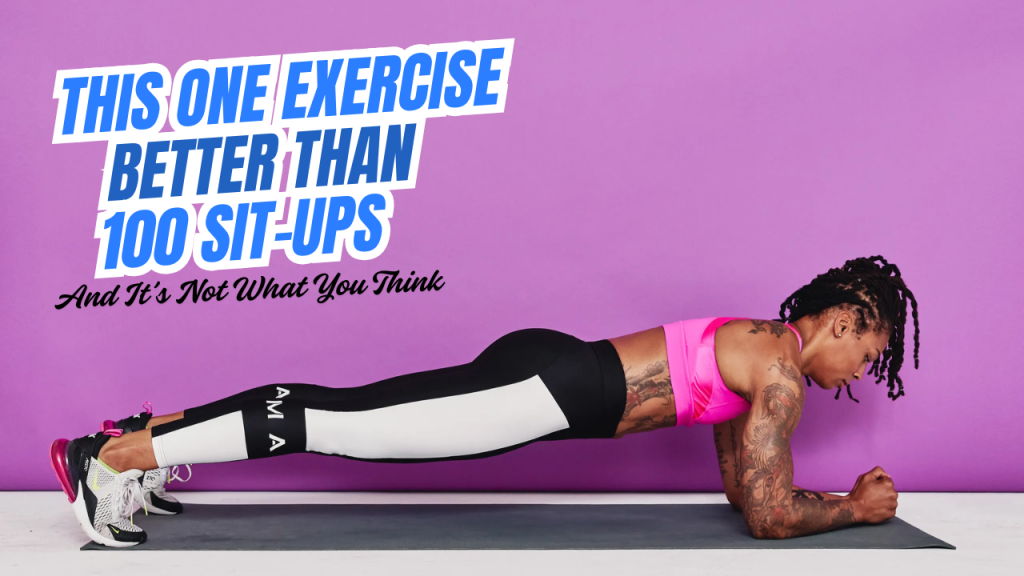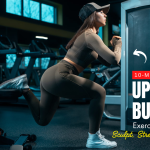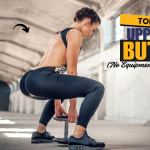Forget the endless crunches – the real secret to a strong, sculpted core doesn’t involve sit-ups at all. In fact, one underrated exercise has been proven to activate more muscle groups, burn more calories, and deliver faster results. The best part? You’re probably not doing it.

The Sit-Up Myth: Why More Isn’t Better
For decades, sit-ups were the go-to move for anyone chasing six-pack abs. But here’s the truth: sit-ups are outdated, and they’re not as effective as you think.
Research has shown that traditional sit-ups:
- Put unnecessary strain on the spine
- Primarily target one small area of the core
- Burn minimal calories
- Don’t contribute much to overall functional strength
Worse, repetitive sit-ups can lead to lower back pain, herniated discs, and poor posture – especially when done incorrectly or excessively.
Perks of Doing Planks Instead of Sit-Ups
- Full-Core Activation
Planks engage the entire core – front, sides, and deep muscles – unlike sit-ups which mainly target the rectus abdominis.- Improves Posture
Strengthening core stabilizers helps maintain a straight spine and upright posture throughout the day.- Reduces Back Pain
Builds lower back strength and reduces the strain on spinal discs, unlike sit-ups which can worsen back issues.- Enhances Balance and Stability
Improves overall body control by working the core in a functional, stabilizing way.- Increases Metabolism
Since planks engage multiple muscle groups, they burn more calories than isolated core exercises.- Boosts Athletic Performance
A strong core supports better movement in running, jumping, lifting, and sports performance.- Requires No Equipment
You can do planks anytime, anywhere – no gym or tools required.- Supports Better Breathing
Strengthening the diaphragm and intercostal muscles aids in deeper, more efficient breathing.- Safer on the Spine
Unlike sit-ups, planks keep the spine neutral and reduce the risk of injury.- Endless Progression Options
From side planks to dynamic plank variations, you can keep challenging your body without getting bored.
Do’s and Don’ts of Doing Planks
| Do’s | Don’ts |
|---|---|
| Keep your body in a straight line | Let your hips sag or lift too high |
| Engage your core and glutes tightly | Relax your core or forget to squeeze |
| Keep your elbows directly under shoulders | Place arms too far forward or back |
| Breathe slowly and steadily | Hold your breath |
| Start with short holds and build gradually | Push yourself to hold too long too soon |
| Focus on form, not duration | Sacrifice form just to beat the clock |
| Add variations to challenge your muscles | Stick to the same plank every session |
| Rest if you feel sharp pain or strain | Push through pain or discomfort |
| Use a mirror to check your posture | Assume your form is correct without feedback |
| Keep your neck neutral, aligned with spine | Look up or down excessively |
What Happens After 30 Days of Doing Planks Daily?
| Day Range | Expected Changes |
|---|---|
| Day 1–7 | – Improved awareness of posture – Slight increase in core activation |
| Day 8–14 | – Better form and endurance – Reduced lower back stiffness |
| Day 15–21 | – Noticeable increase in core strength – Enhanced balance and stability |
| Day 22–30 | – Visible core definition (if combined with proper diet) – Improved full-body coordination |
| By Day 30 | – Stronger, tighter midsection – Flatter stomach – Less back pain – Better athletic performance |
The Game-Changer: The Plank – Simple, but Powerful
The exercise that beats 100 sit-ups? The Plank.
Yes, the plank. It might sound basic, but when done correctly and progressively, it engages more core muscles, including the transverse abdominis, obliques, rectus abdominis, and even the glutes, shoulders, and back.
Unlike sit-ups, the plank:
- Strengthens the entire core unit
- Enhances posture and spinal alignment
- Increases stability and balance
- Activates deep abdominal muscles that sit-ups often miss
- Builds endurance and full-body control
Why Planks Work Better
The plank is an isometric exercise, meaning you hold a position instead of moving through a range of motion. This creates constant tension, which stimulates muscle engagement more deeply than repetitive crunching motions.
A 2014 study published in the Journal of Strength and Conditioning Research found that planks produced higher muscle activation in the obliques and core stabilizers compared to traditional sit-ups. That means you’re working smarter, not harder.
Variations That Skyrocket Results
To keep your core challenged and avoid plateaus, try these powerful plank variations:
- Forearm Plank – The classic. Elbows under shoulders, back straight.
- Side Plank – Targets the obliques and improves lateral strength.
- Plank with Shoulder Taps – Adds instability and works the arms and core.
- Plank to Push-Up – Builds strength and cardio endurance.
- RKC Plank (Hardstyle Plank) – Engage every muscle like you’re about to explode. This variation is intense and hyper-effective.
Pro Tip: It’s Not About How Long – It’s About How You Engage
Many people think planks are all about holding as long as possible. Wrong.
Instead, focus on muscle engagement:
- Brace your core like someone’s going to punch you
- Squeeze your glutes
- Push away from the floor to activate your upper body
- Keep your body in a straight line – no sagging or arching
30–60 seconds of a perfectly executed plank is far more effective than minutes of sloppy holds or hundreds of sit-ups.
Extra Edge: Combine Planks with Functional Movements
To truly build a rock-solid core and boost athletic performance, combine planks with compound exercises like:
- Deadlifts
- Squats
- Push-ups
- Kettlebell swings
These moves also require core stabilization, making your entire body stronger and more resilient.
Benefits Beyond Aesthetics
Strong abs look great, but the benefits of plank training go far deeper:
- Improved posture
- Reduced risk of injury
- Better sports performance
- Enhanced mobility and flexibility
- Back pain relief
- Increased calorie burn due to full-body muscle engagement
Final Word: Ditch the Sit-Ups, Embrace the Plank
If your fitness goal is to build a strong, lean, and injury-resistant core, it’s time to retire the sit-up and embrace smarter training. Planks are simple, efficient, and far more beneficial than crunching your spine for 30 minutes straight.
So the next time you’re tempted to knock out 100 sit-ups, remember: One perfectly executed plank is worth more than all of them.
Frequently Asked Questions (FAQs)
Why are planks better than sit-ups for core strength?
Planks engage the entire core, including deep stabilizing muscles like the transverse abdominis and obliques, which sit-ups often miss. They also improve posture, reduce injury risk, and avoid the spinal strain that comes with repeated sit-ups.
How long should I hold a plank to see results?
Start with 20–30 seconds and build up to 60 seconds with perfect form. Quality matters more than duration. Focus on muscle engagement rather than holding for as long as possible.
Can planks help me get six-pack abs?
Planks strengthen and define your core muscles, but visible abs also depend on body fat percentage. Combine planks with proper nutrition and cardio for the best results.
Are planks safe for beginners?
Yes! Planks are low-impact and easy to modify. Beginners can start with a kneeling plank or hold shorter durations, gradually building endurance and strength.
How often should I do planks?
You can safely do planks 3–5 times per week. Even daily planks are okay if you vary the types and give muscles time to recover.
What muscles do planks work besides the abs?
Planks also activate the glutes, shoulders, back, chest, and even legs. It’s a full-body movement that trains stability and muscular endurance.
What if I feel pain in my back during planks?
Back pain often means poor form. Make sure your hips don’t sag and your core is engaged. If pain persists, try regressions like incline planks or consult a fitness professional.





